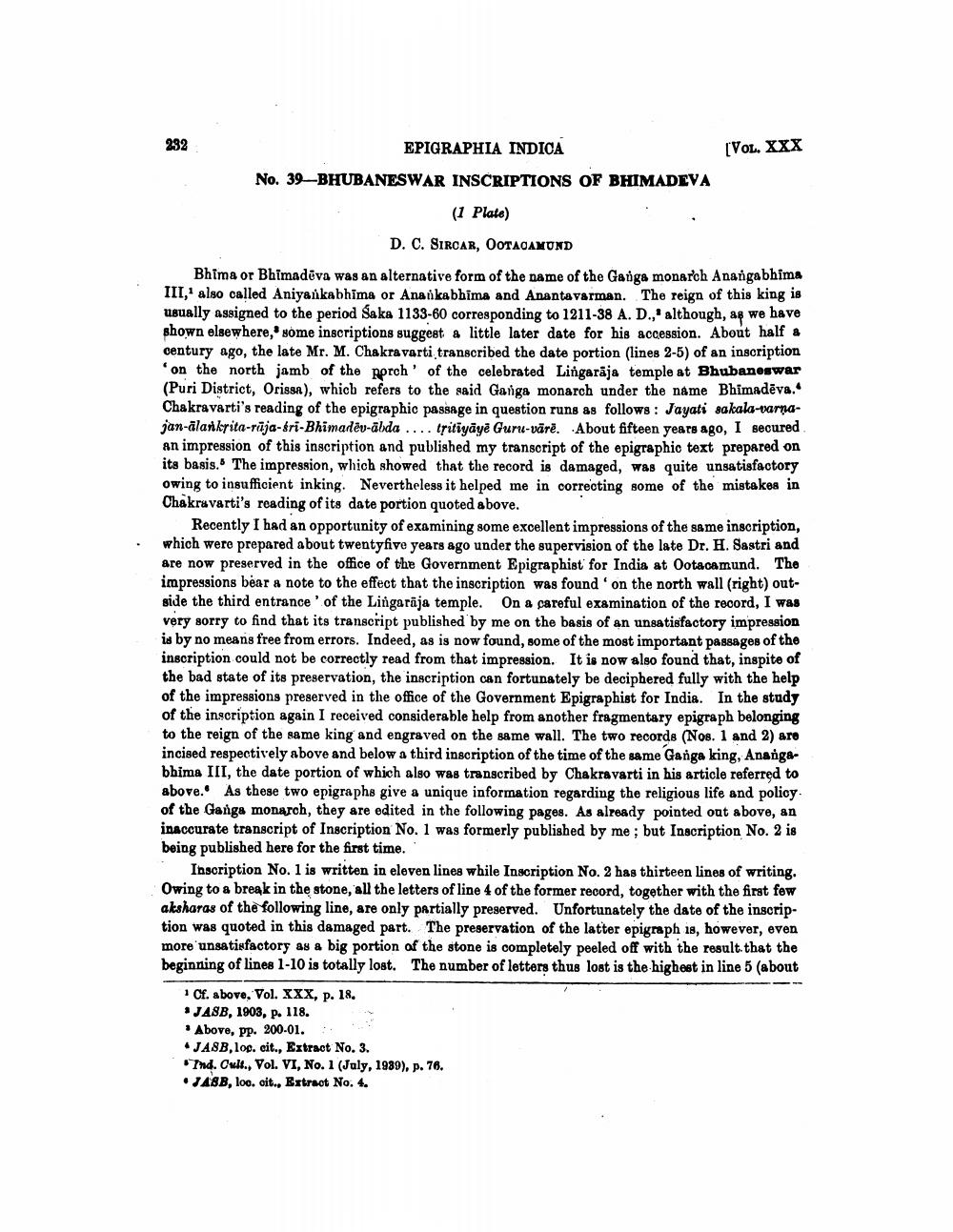________________
232
[VOL. XXX
EPIGRAPHIA INDICA No. 39--BHUBANESWAR INSCRIPTIONS OF BHIMADEVA
(1 Plate) D. C. SIRCAR, OOTAQAMUND
Bhima or Bhimadeva was an alternative form of the name of the Ganga monarch Anangabhima III, also called Aniyankabhima or Anankabhima and Anantavarman. The reign of this king is usually assigned to the period Saka 1133-60 corresponding to 1211-38 A.D.,' although, as we have shown elsewhere, some inscriptions suggest a little later date for his accession. About half a century ago, the late Mr. M. Chakravarti transcribed the date portion (lines 2-5) of an inscription
on the north jamb of the porch' of the celebrated Lingaraja temple at Bhubanoswar (Puri District, Orissa), which refers to the said Ganga monarch under the name Bhimadēva. Chakravarti's reading of the epigraphic passage in question runs as follows: Jayati sakala-varnajan-alankrita-rīja-fri-Bhimadēv-ābda .... tritiyāye Gure-vārë. About fifteen years ago, I secured an impression of this inscription and published my transcript of the epigraphic text prepared on its basis. The impression, which showed that the record is damaged, was quite unsatisfactory owing to insufficient inking. Nevertheless it helped me in correcting some of the mistakes in Chakravarti's reading of its date portion quoted above.
Recently I had an opportunity of examining some excellent impressions of the same inscription, which were prepared about twentyfive years ago under the supervision of the late Dr. H. Sastri and are now preserved in the office of the Government Epigraphist' for India at Ootacamund. The impressions bear a note to the effect that the inscription was found on the north wall (right) outside the third entrance of the Lingarāja temple. On a careful examination of the record, I was very sorry to find that its transcript published by me on the basis of an unsatisfactory impression is by no means free from errors. Indeed, as is now found, some of the most important passages of the inscription could not be correctly read from that impression. It is now also found that, inspite of the bad state of its preservation, the inscription can fortunately be deciphered fully with the help of the impressions preserved in the office of the Government Epigraphist for India. In the study of the inscription again I received considerable help from another fragmentary epigraph belonging to the reign of the same king and engraved on the same wall. The two records (Nos. 1 and 2) aro incised respectively above and below a third inscription of the time of the same Ganga king, Anangabhima III, the date portion of which also was transcribed by Chakravarti in his article referred to above. As these two epigraphs give a unique information regarding the religious life and policy of the Ganga monarch, they are edited in the following pages. As already pointed out above, an inaccurate transcript of Inscription No. 1 was formerly published by me; but Inscription No. 2 is being published here for the first time."
Inscription No. 1 is written in eleven lines while Inscription No. 2 has thirteen lines of writing. Owing to a break in the stone, all the letters of line 4 of the former record, together with the first few aksharas of the following line, are only partially preserved. Unfortunately the date of the inscription was quoted in this damaged part. The preservation of the latter epigraph 18, however, even more'unsatisfactory as a big portion of the stone is completely peeled off with the result that the beginning of lines 1-10 is totally lost. The number of letters thus lost is the highest in line 5 (about
Cf. above, Vol. XXX, p. 18. • JASB, 1903, p. 118. . Above, pp. 200-01. JASB. lop. cit., Extract No. 3.
Ind. Owll., Vol. VI, No. 1 (July, 1989), p. 76. • 7A8B, loo. cit., Extract No. 4.




